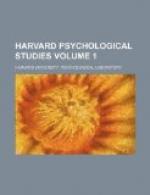II.
I began my work on the problem in question by attempting to verify with similar apparatus the results of some of the previous investigations, in the hope of discovering just where the suspected error lay. It is unnecessary for me to give in detail the results of these preliminary series, which were quite in agreement with the general results of Parrish’s experiments. Distances of six centimeters filled with points varying in number and position were, on the whole, underestimated in comparison with equal distances without intermediate point stimulations. So, too, the card with saw-toothed notches was judged shorter than the card of equal length with all but the end points cut out.
After this preliminary verification of the previous results, I was convinced that to pass from these comparatively meager statistics, gathered under limited conditions in a very special case, to the general statement that the optical illusion is reversed in the field of touch, is an altogether unwarranted procedure. When one reads the summarized conclusions of these previous investigators, one finds it there assumed or even openly asserted that the objective conditions of the tactual illusion are precisely the same as those of the optical illusion. But I contend that it is not the real analogue of the optical illusion with which these experiments have been concerned. The objective conditions are not the same in both. Although something that is very much like the optical illusion is reversed, yet I shall attempt to prove in this part of my paper, first, that the former experiments have not been made with the real counterpart of the optical illusion; second, that the optical illusion can be quite exactly reproduced on the skin; third, that where the objective conditions are the same, the filled cutaneous space is overestimated, and the illusion thus exists in the same sense for both sight and touch.




